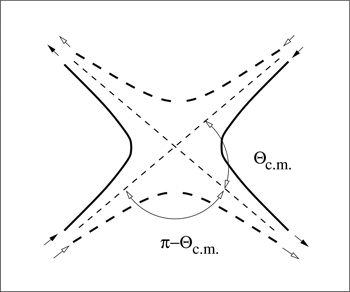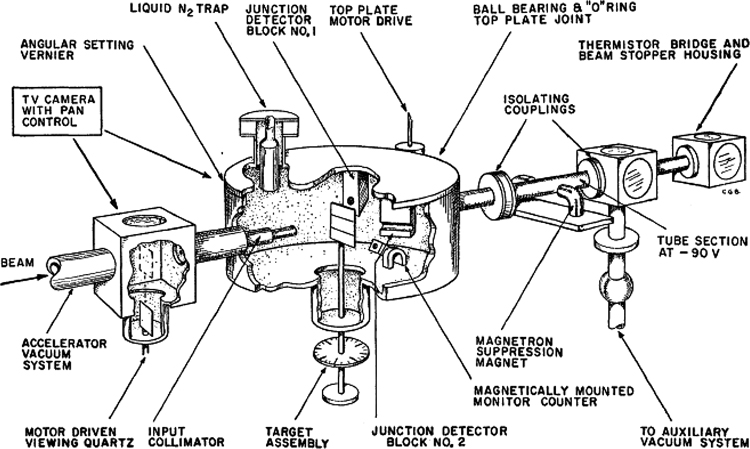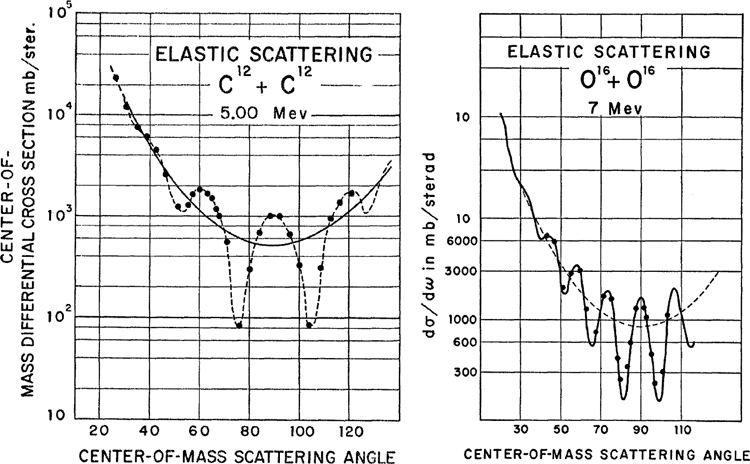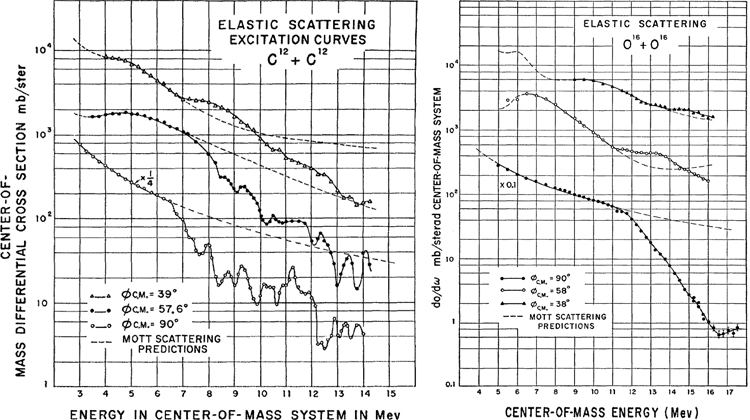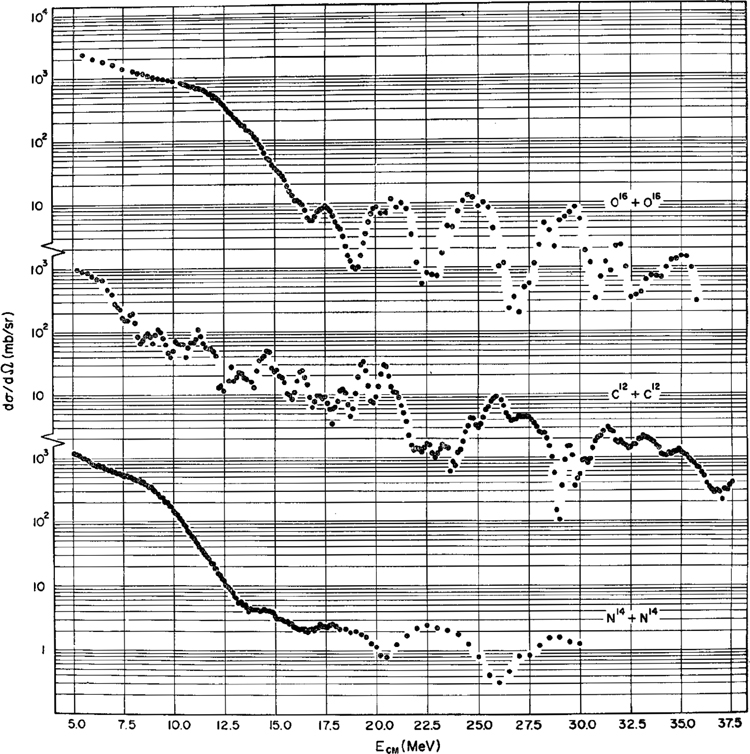Scattering of identical nuclei, exchange symmetry and molecular resonances
Published October 2015
•
Copyright © IOP Publishing Ltd 2015
Pages 13-1 to 13-9
You need an eReader or compatible software to experience the benefits of the ePub3 file format.
Download complete PDF book or the ePub book
Abstract
Scattering and reactions of (lighter) heavy ions show features of direct-interaction as well as compound-nuclear (CN) processes. In elastic scattering, e.g. of 12C or 16O on similar nuclei, intermediate structures have been observed that have been interpreted as the formation of relatively short-lived nuclear molecules. A special case is the (sub-Coulomb) scattering of identical nuclei where quantum interference (in analogy to Young's double-slit experiment in optics) is observed which, in addition, depends crucially on the spin/statistics of the nuclei, i.e. whether they are bosons or fermions.
In quantum mechanics identical particles are indistinguishable. In a reaction between identical nuclei this applies to forward-scattered nuclei and backward-scattered recoil nuclei. These particles must interfere independent of the reaction mechanisms and the type of interaction, i.e. classical or semi-classical approaches to describe such reactions are unsuitable in principle.
13.1. The first observation of interference in the scattering of identical nuclei
To best see the quantum interference of identical particles it is useful to stay below
the Coulomb barrier (sub-Coulomb scattering), i.e. where nuclear
effects can be kept small. Then one has to deal with calculable (Rutherford) amplitudes
only. In addition to the forward scattering Rutherford cross section there is a
corresponding recoil Rutherford term plus an interference term between both. In the
scattering of identical particles a detector at the center-of-mass (c.m.) angle
θ is unable to distinguish whether it registers forward-scattered
ejectiles under θ or, under the angle  , backward-emitted recoils. This is shown in figure 13.1. The formal scattering
theory (see below) shows that the angular distributions must be symmetric around
, backward-emitted recoils. This is shown in figure 13.1. The formal scattering
theory (see below) shows that the angular distributions must be symmetric around  and therefore must be described by even-order Legendre polynomials.
Quantum-mechanically, in addition, it is to be expected that the forward- and
backward-scattered particle waves interfere. In this case no classical description of
the scattering process is possible. In addition, the details of the interference depend
on the spin structure of the interacting particles: identical bosons behave differently
from identical fermions and when the particles have spin
and therefore must be described by even-order Legendre polynomials.
Quantum-mechanically, in addition, it is to be expected that the forward- and
backward-scattered particle waves interfere. In this case no classical description of
the scattering process is possible. In addition, the details of the interference depend
on the spin structure of the interacting particles: identical bosons behave differently
from identical fermions and when the particles have spin  (i.e. always for fermions) the spin states must be coupled and
superimposed in the cross section with their spin multiplicities as weighting factors.
The following examples, which can be tested experimentally, will explain this.
(i.e. always for fermions) the spin states must be coupled and
superimposed in the cross section with their spin multiplicities as weighting factors.
The following examples, which can be tested experimentally, will explain this.
Figure 13.1. Trajectories of identical particles in the c.m. system.
Download figure:
Standard image High-resolution image13.1.1. Identical bosons with spin I = 0
Here

13.1.2. Identical fermions with spin 
For the fermions the spin singlet cross section

and the triplet cross section

in the total (integrated) cross section must be added incoherently, each weighted with their spin multiplicities:

In these two cases the interference has opposite signs which, e.g. at  , has the consequence that in the case of two bosons there is an
interference maximum, for fermions a minimum. Under the special assumption that there
is no spin–spin force acting (
, has the consequence that in the case of two bosons there is an
interference maximum, for fermions a minimum. Under the special assumption that there
is no spin–spin force acting ( ), and with
), and with  one obtains for identical fermions a decrease, for identical bosons
an increase each by a factor of 2 compared to the classical cross section.
one obtains for identical fermions a decrease, for identical bosons
an increase each by a factor of 2 compared to the classical cross section.
For pure (sub-)Coulomb scattering (meaning: Coulomb scattering at energies sufficiently below the Coulomb barrier) of identical particles the scattering amplitudes can be calculated explicitly (i.e. also summed over partial waves) since we deal with the Rutherford amplitude known from scattering theory, see section 2.1.3:

In addition to the forward scattering Rutherford cross section there is
a corresponding recoil Rutherford term plus an interference term between both. Figure
13.2 shows this
behavior, which is analogous to that of light in Young's double-slit experiment, but
additionally shows the influence of spin and statistics. Two fermions show destructive
interference at π/2 whereas two bosons interfere constructively. In
fact the experiments could be used to determine the spins of the particles involved
from the 'amplitude' of the interference pattern. Above the Coulomb barrier,
additional terms including interference terms arise from the hadronic interaction. A
special example is low-energy proton–proton scattering in which, for S-waves, one
nuclear phase shift  must be considered for which, e.g. a 'nuclear' scattering length
must be considered for which, e.g. a 'nuclear' scattering length  may be obtained (see section 12.3.2).
may be obtained (see section 12.3.2).
Figure 13.2. Experimental c.m. angular distributions of Coulomb scattering of two identical
bosons (12C) and fermions (13C) as well as of two
non-identical particles of nearly equal masses and theoretical cross sections at  . The angular distribution for the non-identical particles is
obtained when the spectra of the forward- and backward-scattered particles cannot
be separated by the detector, which is the case for (nearly) equal masses.
Otherwise one would obtain a typical Rutherford distribution for the
forward-scattered particle and a distribution reflected about 90° for the recoil
particle. The data were measured by students of an advanced laboratory course at
IKP Cologne in 2003.
. The angular distribution for the non-identical particles is
obtained when the spectra of the forward- and backward-scattered particles cannot
be separated by the detector, which is the case for (nearly) equal masses.
Otherwise one would obtain a typical Rutherford distribution for the
forward-scattered particle and a distribution reflected about 90° for the recoil
particle. The data were measured by students of an advanced laboratory course at
IKP Cologne in 2003.
Download figure:
Standard image High-resolution image13.2. Studies of heavy-ion reactions and intermediate structure
The first and key experiments designed specifically to study the scattering of
identical bosons and at the same time details of the heavy-ion interactions and
structure were performed by Bromley et al [4, 5]. Scattering of identical spin-zero nuclei
was investigated. Larger tandem Van de Graaff accelerators had become available as well
as compact solid-state detectors. Both are especially suited to studying heavy-ion
reactions, the accelerators because of the possible high energies for heavy ions due to
the multiple charge states of the ion beams, excellent energy definition and stability,
and ease of changing energy and targets, the latter because of the possibility of using
many small detectors providing good angular resolution and relatively thin depletion
layers. Thus, measurements of the highly structured cross sections, both in angle and
energy, were facilitated. Figure 13.3 shows the scattering chamber set-up used in [5]. Figure 13.4 shows a selection of the angular
distributions for  –
– and
and  –
– elastic scattering at energies below the Coulomb barriers such that
the Mott cross section applies. The interference pattern for identical boson scattering
is evident. One of the earliest measurements of elastic scattering between identical
fermions (
elastic scattering at energies below the Coulomb barriers such that
the Mott cross section applies. The interference pattern for identical boson scattering
is evident. One of the earliest measurements of elastic scattering between identical
fermions ( –
– ) was performed by Voit et al [9], see also figure 13.2 for details of the spin and statistics.
Figure 13.5 compares
excitation functions for
) was performed by Voit et al [9], see also figure 13.2 for details of the spin and statistics.
Figure 13.5 compares
excitation functions for  –
– and
and  –
– elastic scattering. It is remarkable that the excitation functions for
the two systems are quite different, i.e. relatively smooth for the
elastic scattering. It is remarkable that the excitation functions for
the two systems are quite different, i.e. relatively smooth for the  case, but with (quasi-)periodic structures for the
case, but with (quasi-)periodic structures for the  scattering (intermediate or gross
structures with superimposed fine structure). These would be typical
signatures for a doorway phenomenon. In fact, these oscillations have
been interpreted as rotational states of nuclear molecules which partly decay into CN
fine-structure states. The excitation functions follow the Mott cross section but with
increasing energy there is a relatively sharp onset of strong absorption (leading to
compound-nucleus formation). The r dependence of the combined potential
of the Coulomb potential, an absorptive (attractive) nuclear potential and the orbital
angular-momentum barrier at higher
scattering (intermediate or gross
structures with superimposed fine structure). These would be typical
signatures for a doorway phenomenon. In fact, these oscillations have
been interpreted as rotational states of nuclear molecules which partly decay into CN
fine-structure states. The excitation functions follow the Mott cross section but with
increasing energy there is a relatively sharp onset of strong absorption (leading to
compound-nucleus formation). The r dependence of the combined potential
of the Coulomb potential, an absorptive (attractive) nuclear potential and the orbital
angular-momentum barrier at higher  could form a shallow minimum with
rotational molecular states as shown in figure 13.6. In contrast to these early measurements
more detailed studies, also at higher energies, exhibit (quasi-)periodic structures,
partly with marked fine-structure oscillations, also in other systems such as
could form a shallow minimum with
rotational molecular states as shown in figure 13.6. In contrast to these early measurements
more detailed studies, also at higher energies, exhibit (quasi-)periodic structures,
partly with marked fine-structure oscillations, also in other systems such as  –
– ,
,  –
– ,
,  –
– ,
,  –
– , and
, and  –
– , see [16]. Three cases are shown in figure 13.7. Later measurements showed intermediate
structures in excitation functions also in several combinations of nuclei, even in
, see [16]. Three cases are shown in figure 13.7. Later measurements showed intermediate
structures in excitation functions also in several combinations of nuclei, even in  –
– , but also between non-identical nuclei,
, but also between non-identical nuclei,  –
– ,
,  –
– and
and  –
– , partly with superimposed (CN) fine structure. An example for a
precise measurement of the fine structures is shown in figure 13.8. For a detailed discussion of nuclear
molecular states and attempts to describe them, e.g. in the framework of the optical
model with shallow or deep optical potentials, see [2]. For general reading on heavy-ion nuclear
physics see the selected references [1, 3, 6, 8, 10–13, 15].
, partly with superimposed (CN) fine structure. An example for a
precise measurement of the fine structures is shown in figure 13.8. For a detailed discussion of nuclear
molecular states and attempts to describe them, e.g. in the framework of the optical
model with shallow or deep optical potentials, see [2]. For general reading on heavy-ion nuclear
physics see the selected references [1, 3, 6, 8, 10–13, 15].
Figure 13.3. The scattering chamber set-up of [5] is shown. It is typical for tandem Van de Graaff experiments with charged particles. Important are a well-focused or collimated beam, thin foil targets, well-defined solid angles at the detectors, precise angle definition of the detector slits and a Faraday cup at the exit for beam charge calibration. For heavy-ion experiments, however, this cannot be used because the charge state equilibrium of the incident beam at the reaction is unknown. Therefore, a cross-section calibration such as using a heavy target (e.g. gold) and a calculable Rutherford cross section has to be used for normalization. Reproduced with permission from [5]. Copyright 1961 American Physical Society.
Download figure:
Standard image High-resolution imageFigure 13.4. Cross-section angular distributions of  –
– and
and  –
– elastic scattering. Reproduced with permission from [5]. Copyright 1961
American Physical Society.
elastic scattering. Reproduced with permission from [5]. Copyright 1961
American Physical Society.
Download figure:
Standard image High-resolution imageFigure 13.5. Excitation functions of  –
– and
and  –
– elastic scattering. Reproduced with permission from [5]. Copyright 1961
American Physical Society.
elastic scattering. Reproduced with permission from [5]. Copyright 1961
American Physical Society.
Download figure:
Standard image High-resolution imageFigure 13.6. Schematic view of the possible shape of a potential allowing for molecular states.
Download figure:
Standard image High-resolution imageFigure 13.7. Excitation functions of  –
– ,
,  –
– and
and  –
– elastic scattering. The excitation functions show indications of
fine structure superimposed on intermediate (molecular resonance) structures.
Reproduced with permission from [14]. Copyright 1973 Springer.
elastic scattering. The excitation functions show indications of
fine structure superimposed on intermediate (molecular resonance) structures.
Reproduced with permission from [14]. Copyright 1973 Springer.
Download figure:
Standard image High-resolution imageFigure 13.8. Excitation functions of  –
– elastic scattering. The excitation functions show a well-resolved
fine structure superimposed on intermediate (molecular resonance) structures. The
dashed line is from an optical-model calculation with an extremely shallow real
potential. Reproduced with permission from [16]. Copyright 1967 American Physical
Society.
elastic scattering. The excitation functions show a well-resolved
fine structure superimposed on intermediate (molecular resonance) structures. The
dashed line is from an optical-model calculation with an extremely shallow real
potential. Reproduced with permission from [16]. Copyright 1967 American Physical
Society.
Download figure:
Standard image High-resolution imageReferences
- [1]Bass R 1980 Nuclear Reactions with Heavy Ions (Texts and Monographs in Physics) (Berlin: Springer)
- [2]Betts R R and Wuosmaa A H 1997 Rep. Prog. Phys. 60 819
- [3]Bock R (ed) 1981 Heavy-Ion Collisions (Amsterdam: North-Holland) vol 1–3
- [4]Bromley D A, Kuehner J A and Almqvist E 1960 Phys. Rev. Lett. 4 365
- [5]Bromley D A, Kuehner J A and Almqvist E 1961 Phys. Rev. 123 868
- [6]Bromley A (ed) 1985 Treatise on Heavy-Ion Science (New York: Plenum) vol 1–8
- [7]Frahn W E 1972 Ann. Phys. NY 72 524
- [8]Goldberger M L and Watson K M 1964 Collision Theory (New York: Wiley)
- [9]Helb H-D, Dück P, Hartmann G, Ischenko G, Siller F and Voit H 1973 Nucl. Phys. A 206 385
- [10]Joachain C 1983 Quantum Collision Theory 3rd edn (Amsterdam: North-Holland)
- [11]Mott N F 1930 Proc. R. Soc. A 126 259
- [12]Mott N F and Massey H S W 1965 The Theory of Atomic Collisions (Oxford: Clarendon)
- [13]Nörenberg W and Weidenmüller H A 1976 Introduction to the Theory of Heavy Ion Collisions (Lecture Notes in Physics) 51 (Heidelberg: Springer)
- [14]Reilly W, Wieland R, Gobbi A, Sachs M W and Bromley D A 1973 Nuovo Cimento A 13 897
- [15]Satchler G R 1990 Introduction to Nuclear Reactions 2nd edn (London: McMillan)
- [16]Siemssen R H, Maher J V, Weidinger A and Bromley D A 1967 Phys. Rev. Lett. 19 369


